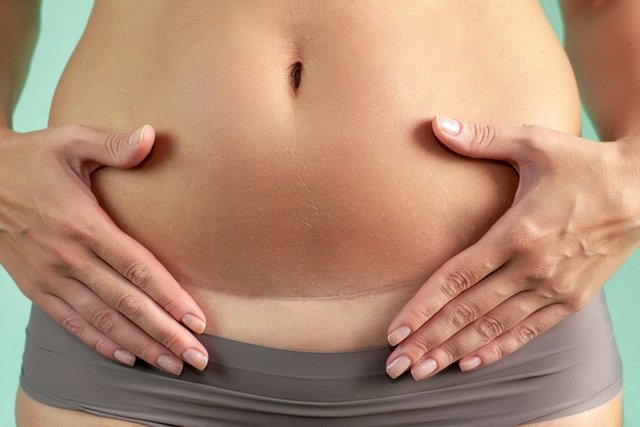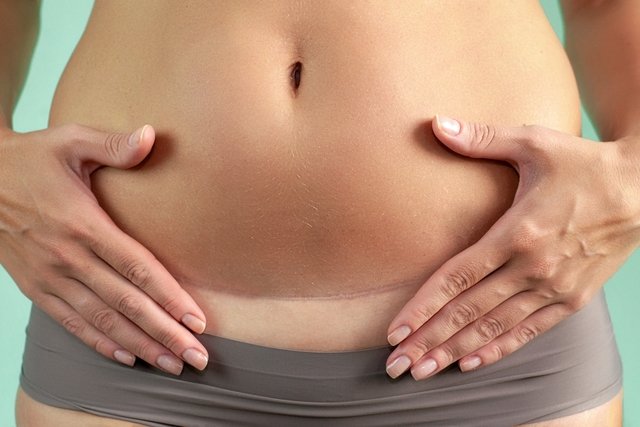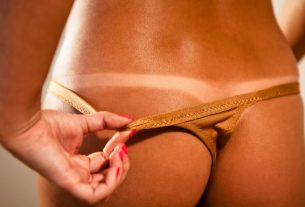To reduce the thickness of the cesarean scar and make it as uniform as possible, you can resort to massages and treatments that use ice, such as cryotherapy, and based on friction, laser or vacuum depending on the recommendation of a dermatologist. It may also be recommended to inject corticosteroids directly into the cesarean section scar, depending on the size of the scar on the skin.
In general, treatment can be started 3 days after surgery if the scar is not open or infected. Initially, massage directly on the properly closed scar helps to remove adhesions and remove possible nodules that leave the scar site hardened. See better how to release the glued scar.
When the scar is very different in color from the person’s skin tone, or if it is hardened, high or very wide, it may be a sign of cesarean scar keloid and, in these cases, treatment with acids can be carried out. specific treatments that are applied by the dermatologist or dermatofunctional physiotherapist.

In order for the cesarean section scar to close faster and become more disguised, being just a small, discreet line on the lower part of the belly, it is recommended to take some precautions according to the surgery time, such as:
1. In the first 7 days
In the first 7 days after surgery, it is recommended to do nothing, just rest and avoid touching the scar to cause infection or opening of the stitches. However, if after this period the scar is not very red, swollen, or releasing liquid, it is possible to start applying a healing cream all around the scar, using gentle movements, so that the product is absorbed by the skin. Check out some types of ointments to apply to the scar.
It is also possible to use moisturizing oil or gel, sleep on your back, supporting your legs well with a pillow on your knees and, if the obstetrician authorizes it, you can perform manual lymphatic drainage on the legs, groin and abdominal region and use a belt to compress the abdominal region, which also helps protect the cesarean section scar.
2. Between the 2nd and 3rd week
After 7 days of the cesarean section, treatment to reduce the scar may also include lymphatic drainage to reduce pain and swelling. To help drain excess liquid, you can use a silicone cup to gently suction the skin, respecting the locations of the vessels and lymph nodes. Understand better how lymphatic drainage is done.
If the cesarean section scar is well closed and dry, the person can start massaging exactly over the scar with circular movements, up and down, from side to side so that the scar does not stick together and pull the skin in place. return. If this happens, in addition to making physiological drainage difficult, it can even make it difficult to stretch the entire belly area.
3. After 20 days
After this period, any changes can now be treated with equipment such as laser, endermology or radiofrequency. If the cesarean scar presents fibrosis, which is when the area becomes hardened, it is possible to remove it with radiofrequency equipment in functional dermatological physiotherapy clinics. Generally 20 sessions are enough to remove much of this tissue, freeing the scar.
4. After 90 days
After 90 days, in addition to the resources indicated, you can also use acid treatment that must be applied directly to the scar. These remain on the skin for a few seconds and must be removed completely and are very effective in eliminating the most superficial layer of the skin, renewing all this tissue.
The acids must be applied by a dermatologist or a qualified dermatological physiotherapist, requiring 1 session per week or every 15 days for 2 or 3 months.
When is it necessary to resort to plastic surgery
When the scar is more than 6 months old and is larger than the rest of the skin around it, when it is very adherent, if there is a keloid or if the appearance is not very uniform and if the person wants immediate treatment, it is best to do plastic surgery to correct the scar.
However, in any case, aesthetic physiotherapy is indicated to carry out treatments that improve the appearance and reduce the thickness of the cesarean section scar, in addition to improving the mobility of the tissues around it, increasing the woman’s quality of life and self-esteem. However, in these situations, instead of 20 or 30 sessions, a longer treatment time may be necessary.
See below a video about essential care to facilitate healing and prevent the scar from sticking:

Sign up for our newsletter and stay up to date with exclusive news
that can transform your routine!
Warning: Undefined array key "title" in /home/storelat/public_html/wp-content/plugins/link-whisper-premium/templates/frontend/related-posts.php on line 12
Warning: Undefined array key "title_tag" in /home/storelat/public_html/wp-content/plugins/link-whisper-premium/templates/frontend/related-posts.php on line 13




